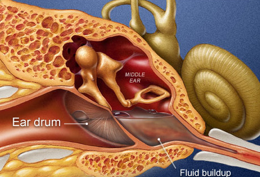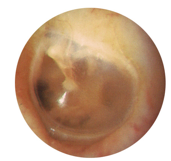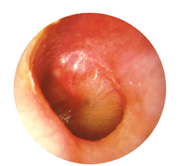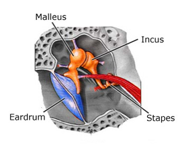Otitis media is the most frequent diagnosis recorded for children who visit physicians for illness. Approximately one-third of all children have more than three ear infections during the first three years of life. This results in 30 million doctor visits per year. Otitis media is also the most common cause of hearing loss in children.
There are three main parts of the ear- the outer ear, the middle ear and the inner ear. The outer ear is just the pinna (the part that sticks out of the head) and the ear canal, which ends at the eardrum. The middle ear is the space behind the eardrum. This space is drained and ventilated by a pathway called the Eustachian tube, which runs from the ear to the back of the nose. The inner ear is deep inside the skull and is where the nerves and other structures controlling hearing and balance are located.
The ear is divided into three parts:
- The outer ear meaning the part of the ear you can see on the side of the head (pinna) plus the ear canal leading down to the eardrum. The ear canal is where earwax accumulates.
- The middle ear: the eardrum and ear bones (ossicles), plus the air spaces behind the eardrum and in the mastoid cavities (vulnerable to air pressure).
- The inner ear: the area that contains the cochlea and nerve endings for the organs of hearing and balance (equilibrium).
Otitis Media is an inflammation of the middle ear and is usually caused by bacteria. It’s the most common illness in babies and young children and occasionally occurs in adults.
This can cause pain, fever, irritability and a temporary hearing loss. The diagnosis is made by seeing this infected yellow-white fluid behind the eardrum. Children with ear infections almost always have some problem hearing because the fluid interferes with the vibration of the eardrum.

What Causes Otitis Media?
Acute otitis media is caused by bacteria (or viruses) that enter from the nose or throat and ascend the eustachian tube to reach the middle ear. This occurs when the eustachian tube is not functioning properly, often because it is inflamed from a cold, sinus or throat infection, or an allergy attack. Infection in the middle ear causes earache, a red inflamed eardrum, and a build-up of pus and mucus behind the eardrum.
Sometimes the eardrum ruptures and pus drains out of the ear. But more commonly, the pus and mucus remain in the middle ear because a swollen, inflamed eustachian tube cannot open up to let it drain naturally. This is called middle ear fluid or effusion or serous otitis media, and it often becomes chronic, that is, it can last for weeks, months, or even years after the acute, painful part of the infection is over. Furthermore, it makes the child subject to frequent recurrences of the acute infection.
Ears can become infected during a cold, allergy or upper respiratory infection. Tubes in the ears can get clogged with mucus and other fluid. When fluid presses on the eardrum, it causes ear pain, swelling and redness.
Symptoms of ear infection include:
- Balance difficulties or dizziness
- Drainage from the ear
- Earache
- Fever
- Hearing problems
- Nausea or vomiting
- Pressure in the ear
Children who don’t yet talk, and can’t verbally express their discomfort, may tug at their ears or cry more than usual.

Normal Eardrum

Acute Otitis Media (Infected Eardrum)
What to Expect at the Doctor’s Examination
During your child’s examination, the doctor will look inside his or her ears, using an instrument called an otoscope. With the otoscope inserted in the ear, the doctor can check for redness and fluid behind the eardrum and see if the eardrum moves in response to air pressure. A mobile (vibrating) eardrum is normal.
In addition, two tests may be performed to give the doctor information that cannot be learned through observation alone. One of these tests is an audiogram, in which tones are sounded at various pitches. An audiogram is used to measure how much hearing loss has occurred. The second test, called a tympanogram, measures the air pressure in the middle ear; this indicates how well the eustachian tube is functioning. These two tests help the doctor determine the severity of the problem and decide on a course of treatment.
You can help the doctor by making sure your child remains quiet and still during the examination. Also, be sure to keep all follow-up appointments with your doctor to help ensure your child’s complete recovery.
Treatment
Ear infections can heal by themselves, but severe infections and infections in infants may require antibiotics. Especially with antibiotics, ear infections begin to clear in a few days although fluid may remain in the middle ear for a few weeks.
For children/adults who keep getting ear infections in spite of using antibiotics, the doctor may recommend surgery to insert small tubes (grommets) into the ear to open airflow and improve drainage. Tubes usually stay in the ear for several months and then fall out on their own.
This involves a small surgical incision (opening) into the eardrum to promote drainage of fluid and to relieve pain. The incision heals within a few days and creates practically no scarring or injury to the eardrum, In fact, the surgical opening often heals over before the ear infection has fully recovered and therefore fluid can reaccumulate. To overcome this problem, your physician can place a tiny hollow tube into the opening in the eardrum. The tube, known as a ventilation tube, helps by equalizing air pressure and preventing the accumulation of fluid in the middle ear. It improves the child’s hearing.
Most of the time, otitis media clears up with proper medication and home treatment. The surgeon selects a ventilation tube for your child that will remain in place for as long as required for the middle ear infection to improve and for the eustachian tube to return to normal. This may require several weeks or even several months. During this time, you must take care to keep water out of the child’s ears because it could start an infection. But otherwise, the tube causes no trouble at all, and you will probably notice a remarkable improvement in the child’s hearing and a welcome decrease in the frequency of ear infections.
Surgically removing a child’s adenoids also can help prevent ear infections.
How do ear infections and fluid affect hearing?
Any time the ear is filled with fluid (infected or clean), there will be a temporary hearing loss. This is because the fluid interferes with the transmission of sound into the hearing nerve. Hearing will almost always return to normal when the fluid goes away.

The Ossicles of the Middle Ear
Fluid in the middle ear affects hearing by interfering with the normal vibration of this system. You can imagine that a drum filled with water would not make a loud sound when hit since the water stops the drumhead from vibrating. In the same way, middle ear fluid stops the eardrum and ossicles from vibrating properly.
